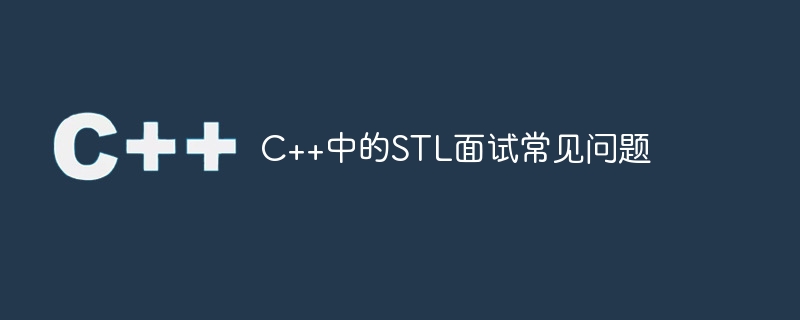

Frequently Asked Questions about STL Interviews in C
STL (Standard Template Library) is an important part of the C standard library. It provides a large number of data structures and Algorithms allow programmers to write code more efficiently and conveniently. For programmers applying for C development positions, their mastery of STL is also the focus of the interviewer. Below are some common STL interview questions, let’s take a look.
STL is part of the C standard library. It provides a set of common data structures and algorithms so that programmers can write code more efficiently and conveniently. STL includes several components such as containers, iterators, algorithms, function objects, and adapters.
STL includes various containers, common ones include vector, list, deque, set, multiset, map and multimap, etc. Among them, vector is a dynamic array, list is a doubly linked list, deque is a double-ended queue, set and multiset are sets implemented based on red-black trees, and map and multimap are dictionaries implemented based on red-black trees.
Commonly used iterators include random access iterators, bidirectional iterators, forward iterators and input and output iterators.
Iterators provide a unified way to access data structure elements, allowing programmers to use the same code and algorithms to operate different data structures. By using iterators, we can easily traverse the elements in the container and perform operations such as additions, deletions, modifications, and searches.
Algorithms are an important part of STL. It provides a variety of commonly used algorithms, including sorting, search, copy, inversion, rotation, copy, etc. Using STL algorithms can greatly simplify code writing and improve program efficiency and readability.
Commonly used algorithms include sorting algorithms (sort), search algorithms (find, lower_bound, upper_bound, etc.), copy algorithms (copy, copy_if, copy_backward, etc.), reversal algorithms (reverse, reverse_copy), etc. .
The function object is an important part of STL. It is actually an object that behaves like a function but has state. Function objects in STL are divided into two types: unary function objects and binary function objects. Commonly used ones include plus, minus, multiplies, divides, modulus, etc.
Adapter is a tool that changes containers, iterators, algorithms and function objects at the interface level. Commonly used ones include function adapters, iterator adapters and container adapters. Adapters in STL can enable incompatible interfaces to be adapted together, improving code flexibility and reusability.
The space allocator is a component in STL used for dynamic memory allocation. It provides a more efficient memory management method and can help programmers avoid problems such as memory leaks and memory fragmentation.
Customizing an STL container requires the following steps: defining the internal data structure of the container, defining iterators, and implementing the member functions of the container, including constructors, destructors, and copy constructors. Move constructor, copy assignment operator, move assignment operator, etc. Finally, you can use custom containers where needed.
Summary
STL is an important component commonly used in C development. Understanding the common problems of STL can help programmers better master C programming. When asked about STL-related questions during interviews, candidates need to have clear ideas and an in-depth understanding of STL so that they can accurately answer the interviewer's questions.
The above is the detailed content of STL interview FAQs in C++. For more information, please follow other related articles on the PHP Chinese website!




